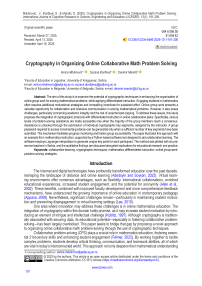Cryptography in Organizing Online Collaborative Math Problem Solving
Автор: Verica Milutinović, Suzana Đorđević, Danimir Mandić
Журнал: International Journal of Cognitive Research in Science, Engineering and Education @ijcrsee
Рубрика: Original research
Статья в выпуске: 1 vol.13, 2025 года.
Бесплатный доступ
The aim of this study is to examine the potential of cryptographic techniques in enhancing the organization of online group work for solving mathematical problems, while applying differentiated instruction. Engaging students in mathematics often requires additional motivational strategies and compelling incentives for sustained effort. Online group work presents a valuable opportunity for collaboration and intensive communication in solving mathematical problems. However, it also poses challenges, particularly concerning academic integrity and the risk of unauthorized copying. To address these issues, this study proposes the integration of cryptographic protocols with differentiated instruction in online collaborative tasks. Specifically, various levels of problem-solving assistance are made accessible only when the majority of the group members reach a consensus. Assistance is unlocked through the submission of individual cryptographic key segments, assigned by the instructor. A group password-required to access incremental guidance-can be generated only when a sufficient number of key segments have been submitted. This mechanism facilitates progress monitoring and fosters group accountability. The paper illustrates this approach with an example from mathematics instruction, supported by a Python-based software tool designed to aid collaborative learning. The software employs Lagrange interpolation to generate unique key parts for each participant. The method was piloted with six pre-service teachers in Serbia, and the qualitative findings are discussed alongside implications for educational research and practice.
Collaborative learning, cryptographic techniques, mathematics differentiated instruction, online group work, problem-solving strategies
Короткий адрес: https://sciup.org/170209054
IDR: 170209054 | УДК: 004.6.056.55; 51:004.42 | DOI: 10.23947/2334-8496-2025-13-1-191-206
Текст научной статьи Cryptography in Organizing Online Collaborative Math Problem Solving
The Internet and digital technologies have profoundly transformed education over the past decade, reshaping the landscape of distance and online learning ( Adedoyin and Soykan, 2023 ). Virtual learning environments offer numerous advantages, such as flexibility, international collaborations, enriched educational experiences, increased student engagement, and the potential for anonymity ( Allen et al., 2002 ). These benefits, combined with improved faculty development and more comprehensive feedback mechanisms, have underscored the growing importance of online education in contemporary pedagogy ( Appana, 2008 ). Nevertheless, significant challenges remain—particularly in maintaining student motivation and preventing disengagement in virtual learning settings ( Lee, 2010 ).
One area where innovation may address these challenges is in online mathematics education. The integration of cryptography within this domain holds promise, as it may increase student motivation by introducing an element of intrigue and intellectual challenge ( Koblitz, 1997 ). Although cryptography is traditionally associated with securing data, its educational potential—especially in fostering collaborative problem-solving—has been largely overlooked. This paper seeks to bridge that gap by proposing a novel approach to organizing online collaborative math problem-solving through the use of cryptographic techniques.

© 2025 by the authors. This article is an open access article distributed under the terms and conditions of the Creative Commons Attribution (CC BY) license .
but also prepares them for real-world challenges that require collaborative efforts and innovative solutions.
The COVID-19 pandemic accelerated digital transformation in education, compelling institutions to rapidly adopt online platforms and practices that otherwise might have taken years to implement ( Adedoyin and Soykan, 2023 ). This transition highlighted the potential of collaborative learning in virtual settings, offering both academic and social benefits to students ( Đorđević and Milutinović, 2021 ). Research suggests that students working collaboratively often outperform individuals working alone, as shared goals promote accountability and active participation ( Johnson and Johnson, 1999 ). Cooperative learning also supports students’ social and psychological needs, fostering interaction and promoting self-directed learning ( Slavin, 1995 ).
Within the context of online math education, group work has emerged as an effective strategy for developing key skills. According to the ISTE standards ( International Society for Technology in Education, 2016 ), students should engage with digital tools to enhance problem-solving, decision-making, and global collaboration. However, the effectiveness of online group work is frequently hampered by issues such as academic dishonesty, intra-group conflict, and unequal participation ( Vienović and Adamović, 2013 ). Cryptography offers a potential solution to these issues by enabling secure, consensus-based collaboration. By assigning unique cryptographic keys to each participant and requiring group agreement to unlock portions of problem-solving tasks, the model can mitigate cheating and foster cooperation.
This paper introduces and explores a cryptographic model designed to structure and support online collaborative mathematics problem-solving. It examines the model’s potential to enhance motivation, ensure academic integrity, and promote meaningful collaboration, thereby addressing a critical gap in the existing literature ( Đorđević and Milutinović, 2021 ).
Research Objective and Question
This study aims to evaluate the effectiveness of a cryptographic model in facilitating collaborative problem-solving and differentiated instruction among pre-service teachers. Specifically, the research seeks to answer the following question:
-
• How does the integration of cryptographic techniques in online collaborative math problem-solving with differentiated instruction influence pre-service teachers’ engagement, mathematical understanding, and collaboration?
Scope and Significance
This study focuses on the design, implementation, and evaluation of a cryptographic model for online collaborative mathematical problem-solving, embedded within a differentiated instruction framework for pre-service teachers. The model assigns unique cryptographic keys to each participant, requiring group consensus to unlock progressive levels of problem-solving support. The significance of this research lies in its potential to:
-
• Enhance student motivation by introducing differentiated instruction elements into the learning process;
-
• Protect academic integrity by mitigating issues such as answer copying and uneven participation;
-
• Foster effective collaboration and the development of 21st-century skills, including critical thinking, communication, and teamwork.
By addressing these aspects, the study contributes to the growing body of knowledge on integrating cryptography into educational practices, offering insights into innovative methods for engaging students and promoting deeper learning in online environments.


